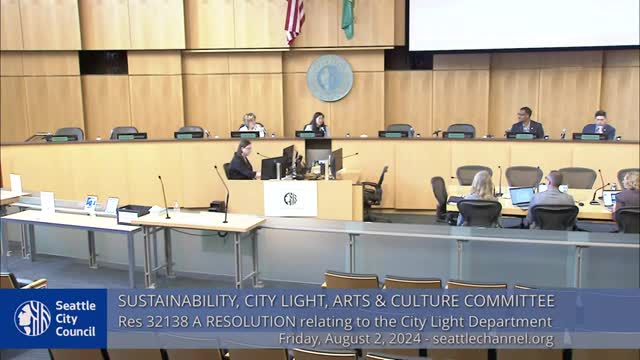City plans bold solar initiative to meet energy demands
August 02, 2024 | Seattle, King County, Washington

This article was created by AI summarizing key points discussed. AI makes mistakes, so for full details and context, please refer to the video of the full meeting. Please report any errors so we can fix them. Report an error »

During a recent government meeting, officials discussed the integration of customer solar resources into the city's energy planning, highlighting its significance in meeting local electricity demands. The plan anticipates generating 12 megawatts from customer-owned solar resources over the next decade, which is seen as a crucial step in reducing reliance on third-party transmission and enhancing sustainability.
The conversation also touched on the comparative analysis of Seattle's energy portfolio with other utilities in the Northwest. Officials noted that while Seattle City Light's peak load is higher than some counterparts, this is largely due to the city's substantial commercial loads, which are sensitive to heating and cooling demands. This reflects broader trends in building and transportation electrification within urban centers.
Additionally, the meeting addressed the alignment of the Integrated Resource Plan (IRP) with the city's strategic planning. Historically, these processes have not coincided, primarily because the city had sufficient resources to meet its steady electricity load. However, with a noticeable increase in demand beginning in 2022, officials emphasized the need for better synchronization moving forward to ensure efficient resource procurement.
The discussions underscored the city's commitment to adapting its energy strategies in response to evolving demands and the importance of continuous evaluation of its planning processes to enhance efficiency and effectiveness.
The conversation also touched on the comparative analysis of Seattle's energy portfolio with other utilities in the Northwest. Officials noted that while Seattle City Light's peak load is higher than some counterparts, this is largely due to the city's substantial commercial loads, which are sensitive to heating and cooling demands. This reflects broader trends in building and transportation electrification within urban centers.
Additionally, the meeting addressed the alignment of the Integrated Resource Plan (IRP) with the city's strategic planning. Historically, these processes have not coincided, primarily because the city had sufficient resources to meet its steady electricity load. However, with a noticeable increase in demand beginning in 2022, officials emphasized the need for better synchronization moving forward to ensure efficient resource procurement.
The discussions underscored the city's commitment to adapting its energy strategies in response to evolving demands and the importance of continuous evaluation of its planning processes to enhance efficiency and effectiveness.
View full meeting
This article is based on a recent meeting—watch the full video and explore the complete transcript for deeper insights into the discussion.
View full meeting
